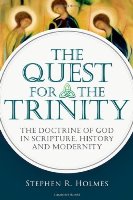A Brief Book Summary from Books At a Glance
by Kirsten Birkett
About the Author
Stephen Holmes is senior lecturer in theology in the School of Divinity, University of St Andrews, Scotland.
Introduction
- ‘The history that God is’: Studying the Doctrine of the Trinity in the Twenty-First Century
- ‘In your light, we see light’: The Trinity in the Bible
- ‘Always with him are his Word and Wisdom’: Early Patristic Developments in the Doctrine of the Trinity
- ‘From the ousia of the Father’: The Fourth-Century Debates 1
- ‘The Godhead is by nature simple’: The Fourth-Century Debates 2
- ‘Understood by a few saints and holy persons’: The West and Augustine
Interlude: The Harvest of Patristic Trinitarianism
- ‘Distinction in the persons but unity in the nature’: The Medieval Doctrine of the Trinity
- ‘By the testimonies of the Scriptures or by manifest reason’: Anti-Trinitarianism from the Reformation to the Eighteenth Century
- ‘A transformation which will go back to its very beginnings’: The Doctrine of the Trinity since 1800
General Summary
An overview of the history of the doctrine of Trinity, comparing twentieth-century debates with earlier doctrinal formulations.
Introduction
The doctrine of the Trinity was settled in the fourth century; recent scholars have claimed to recapture it, but have departed from it.
-
‘The history that God is’: Studying the Doctrine of the Trinity in the Twenty-First Century
“Recent writers have found in the Trinity not just the essence of Christian faith, but a seemingly endlessly generative doctrine for ethical and social ideas.” However many present ideas are not found in earlier accounts of Trinity, and in some cases are ideas previously considered heretical.
Late nineteenth-century theology considered Trinitarian doctrine wrong or useless, but Barth’s Trinitarian doctrine identified God and grounded revelation. The uniqueness of the Christian God had been downplayed, and after Schleiermacher theology was seen as analysis of religious feeling. Barth rejected this and saw Trinity as what distinguishes Christian doctrine of God as Christian. He focussed on Christ as the way to know God: “God reveals God by means of God.” He departed from Reformation tradition in denying any existence of the Second Person that is not Jesus Christ: the incarnation is not a “second moment.” Barth did not use “person” (to avoid the idea of three personalities) but “mode of being.”
Karl Rahner insisted the economic Trinity is the immanent Trinity (“Rahner’s rule”). The Gospel narratives became the key, or only, data for Trinity. John Zizioulas emphasised the persons and against the Western tradition said that Father is the “source or cause” of the Trinity; volition is possessed by the Father, not the Trinity. This emphasis on the persons overtakes unity of substance.
A new view developed of God as not timeless, eternal Creator outside history, but God within history. Pannenberg saw God’s lordship as provisional until demonstrated eschatologically, and the economic relations described in the Gospels as definitive of the immanent Trinity, rather than just of the incarnate Jesus’ relationship with God. More than that, creation itself becomes part of the relationship: the life of God becomes dependent on the world.
Jurgen Moltmann considered monotheism as tending to imperialism, and so rejected the monarchy of God. Instead, he held to a social Trinity: three persons mutually interrelated with no hierarchy. He held the cross as essential to the immanent Trinity and accepted that this means that God is “caused by the world” and so aseity is surrendered.
Robert Jenson asserts that Jesus’ human nature shared some of the divine nature and vice versa. The overarching concept is narrative: “The triune God is a story, a story of community, of mutuality and conversation.” Moreover “God is the gospel history; the Jewish man Jesus is the Second person of the Trinity; the eternal generation of the Son is the event of incarnation.” He asserts clearly that classical theology must be thoroughly revised if Rahner’s rule is taken seriously.
Such revisions in Trinitarian theology have resulted in different accounts of church. Leonardo Boff insisted church based on (Moltmann’s) trinitarian communion “cannot tolerate” hierarchy based on class, gender, etc. Zizioulas in contrast derived a male hierarchy from his view of Father being cause of Son and Spirit. Miroslav Volf claims to derive congregationalist church polity from the same view, but in fact differentiates between relations of origin and love in the Godhead, so there is no priority of the Father; this seems driven by his ecclesiology. In general, efforts to drive social theory from Trinity come from the move to see personhood as univocal.
Analytic philosophy sees traditional Trinitarianism as logically incoherent. Social trinitarianism (Cornelius Plantinga and Richard Swinburne) sacrifices traditional accounts of divine unity and simplicity in favour of other types of close relationships. Latin trinitarianism (Brian Leftow) safeguards divine unity but tends to modalism. Relative identity (Micheal Rea) uses the analogy of marble carved into a statue used as a pillar; they are both marble, but two identities. All these discussions seem to assume univocal language. . . .
[To continue reading this summary, please see below....]The remainder of this article is premium content. Become a member to continue reading.
Already have an account? Sign In
